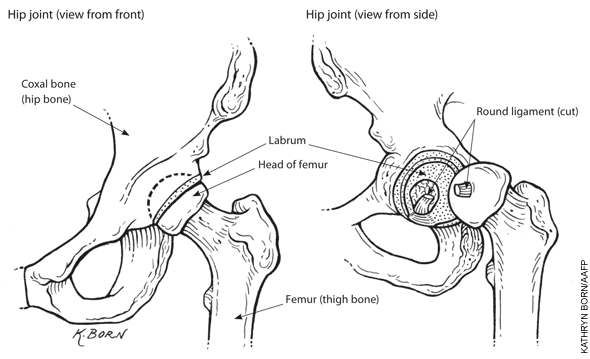
Am Fam Physician. 2009;80(12):1439-1440
See related article on hip impingement.
What is hip impingement?
Hip impingement (im-PINJ-ment) is when two bones rub against each other in the hip joint. It is also called femoroacetabular impingement (FEM-uh-ro-ASS-uh-TAB-yoo-lar im-PINJ-ment, or FAI for short). The hip joint has two bones that fit together like a ball in a socket (see drawing). In some people, these bones press against each other and cause pain. Tissue called the labrum (LAY-brum) cushions the hip joint. Hip impingement can injure the labrum. This causes pain and can lead to arthritis if it is not treated.
Why does it happen?
Most people with hip impingement have an unusually shaped hip joint that causes the bones to press against each other.
How can I tell if I have it?
Hip impingement typically causes pain in the front and outside of the hip area. You might have pain when you sit for a long time, lean forward to put on socks or shoes, get in or out of a car, or pivot when playing sports.
Talk to your doctor if you are having hip problems. He or she will examine your hip while moving it in different directions. You might need to have x-rays to see if there are signs of hip impingement.
Some people need a test where dye is put into the hip with a needle, then pictures are taken of the joint. Your doctor will give you pain medicine before you have this test. If your pain goes away for a little while, then you know it is coming from inside the hip joint. If not, then your pain probably is not from impingement.

How is it treated?
Hip impingement is usually treated with physical therapy. It helps make your muscles stronger and more flexible, which should help the pain. If you still have pain after physical therapy, your doctor may recommend that you see an orthopedic surgeon to discuss whether surgery is the best choice for you.
